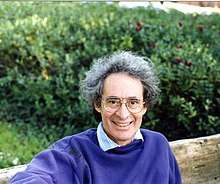
Barry Mazur, 1992
Barry Charles Mazur (born December 19, 1937) is an American mathematics professor at Harvard University, known from his work on geometric and arithmetic topology.
Quotes
- Number theory swarms with bugs, waiting to bite the tempted flower-lovers who, once bitten, are inspired to excesses of effort!
- Barry Mazur, (1991). "Number Theory as Gadfly". Amer. Math. Monthly 98: 593–610.
- Sometimes the mathematical anti-Platonist believes that headway is made by showing Platonism to be unsupportable by rational means, and that it is an incoherent position to take when formulated in a propositional vocabulary. It is easy enough to throw together propositional sentences. But it is a good deal more difficult to capture a Platonic disposition in a propositional formulation that is a full and honest expression of some flesh-and-blood mathematician’s view of things. There is, of course, no harm in trying—and maybe its a good exercise. But even if we cleverly came up with a proposition that is up to the task of expressing Platonism formally, the mere fact that the proposition cannot be demonstrated to be true won’t necessarily make it vanish. There are many things—some true, some false— unsupportable by rational means.
- Barry Mazur, (2008). "Mathematical Platonism and its opposites". Newsletter of the European Mathematical Society: 19–21.
"WHAT IS...a Motive?" 2004
Barry Mazur, (2004). "WHAT IS...a Motive?". Notices of the AMS 51 (10): 1214–1216.
- Hodge cohomology, algebraic de Rham cohomology, crystalline cohomology, the étale ℓ-adic cohomology theories for each prime number ℓ ... A strategy to encapsulate all the different cohomology theories in algebraic geometry was formulated initially by Alexandre Grothendieck, who is responsible for setting up much of this marvelous cohomological machinery in the first place. Grothendieck sought a single theory that is cohomological in nature that acts as a gateway between algebraic geometry and the assortment of special cohomological theories, such as the ones listed above—that acts as the motive behind all this cohomological apparatus. ...
- Vladimir Voevodsky and his collaborators have provided us with a very interesting candidate-category of motives: a category (of sheaves relative to an extraordinarily fine Grothendieck-style topology on the category of schemes) which in some intuitive sense “softens algebraic geometry” so as to allow for a good notion of homotopy in an algebro-geometric setup and is sufficiently directly connected to concrete algebraic geometry to have already yielded some extraordinary applications. The quest for a full theory of motives is a potent driving force in complex analysis, algebraic geometry, automorphic representation theory, the study of L functions, and arithmetic. It will continue to be so throughout the current century.
External links
This article is issued from
Wikiquote.
The text is licensed under Creative
Commons - Attribution - Sharealike.
Additional terms may apply for the media files.